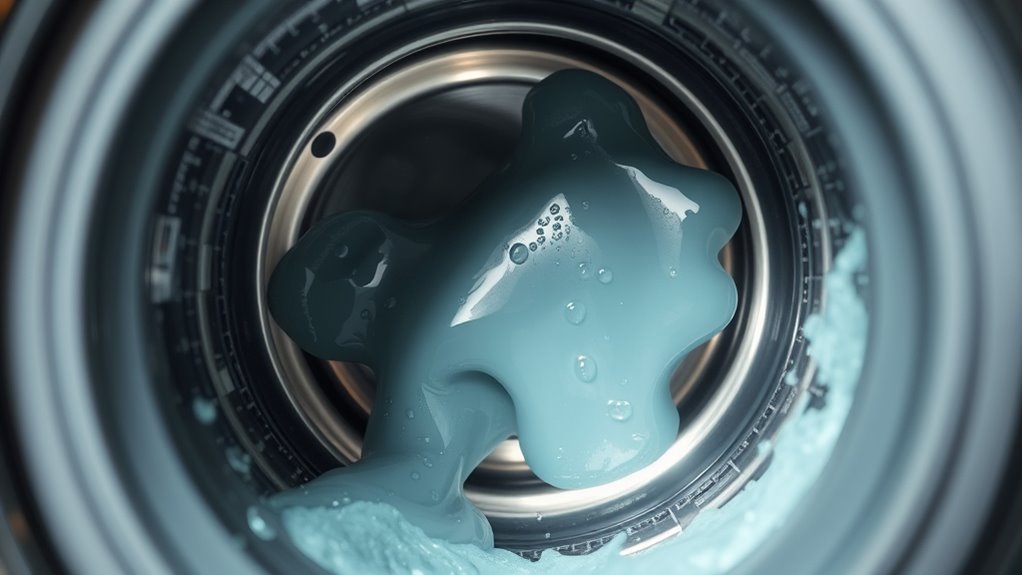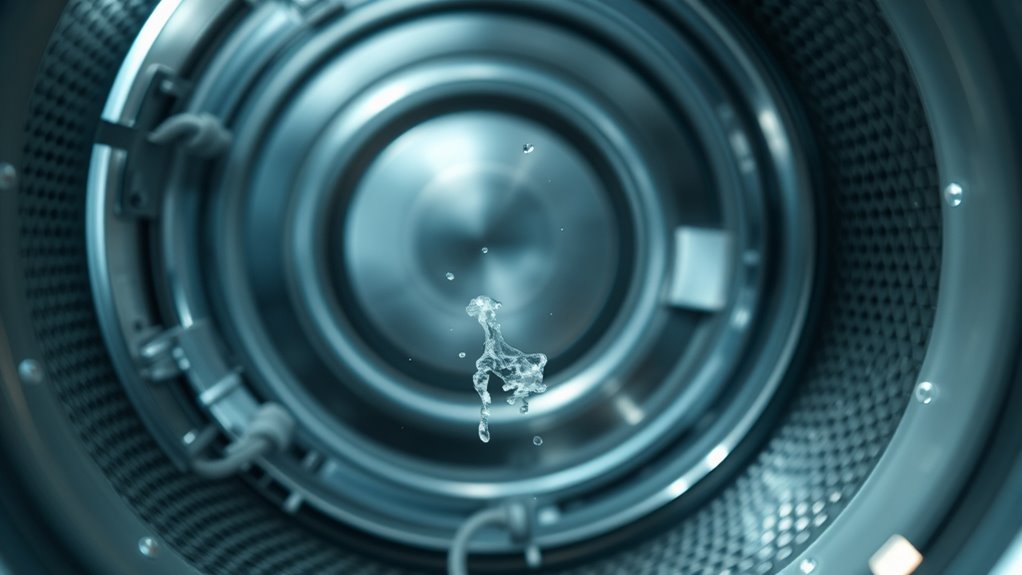To remove hidden slime behind your washer drum, run an empty hot water cycle with vinegar and baking soda or a commercial cleaner. Focus on cleaning the rubber door gasket with a soft brush or cloth, wiping it dry afterward. Regularly clean the detergent drawer and leave the door slightly open after each wash to air out the interior. If you’re curious about more effective cleaning tips, you’ll find plenty of helpful advice ahead.
Key Takeaways
- Regularly run a hot water cycle with vinegar or a washer cleaner to dissolve hidden slime and mold behind the drum.
- Clean the rubber door gasket thoroughly with a soft cloth or brush to remove trapped residue and prevent mold buildup.
- Remove and clean the detergent drawer to eliminate clogs and residue that contribute to slime formation behind the drum.
- Leave the washer door slightly open after each cycle to promote air circulation and inhibit mold growth.
- Schedule monthly deep cleaning routines to maintain hygiene and prevent slime accumulation in hard-to-reach areas.

Over time, dirt, soap scum, and bacteria can build up inside your washer, leading to unpleasant odors and reduced performance. One of the most common culprits is detergent buildup, which can accumulate in the drum, seals, and hoses if you’re not careful. This buildup not only causes foul smells but also creates an ideal environment for mold to thrive. To keep your washer fresh and functioning properly, regular deep cleaning is essential, especially to prevent mold and soap scum from taking hold.
Regular deep cleaning prevents odor, mold, and soap scum buildup for a fresh, efficient washer.
The key to effective deep cleaning is understanding how detergent buildup happens. When you use too much detergent or switch between different types without rinsing thoroughly, excess soap can linger. Over time, this residue combines with dirt and moisture, forming a slimy film inside the drum and around rubber door seals. This slime is a breeding ground for mold and bacteria, which produce musty odors and can even stain your laundry. Regularly cleaning your washer removes this film, preventing mold from developing and ensuring your clothes come out fresh.
To combat detergent buildup and promote mold prevention, start by running an empty hot water cycle with a washer cleaner or a mixture of white vinegar and baking soda. This helps dissolve soap scum and break down any mold spores lurking inside. Pay special attention to the rubber door gasket, as grime often hides there. Use a soft cloth or brush to scrub away slimy residue, and wipe dry afterward to prevent moisture from lingering. Ensuring the door is left slightly open after each wash allows air to circulate and helps keep the interior dry, further reducing mold risk.
In addition to routine maintenance, check your detergent drawer for buildup. Remove and clean it regularly with warm water and a brush, removing any dried soap or fabric softener. This prevents clogs and ensures your detergent dispenses correctly. Also, consider switching to high-efficiency (HE) detergents, which produce less suds and reduce the chance of buildup. Always use the recommended amount of detergent, as overuse accelerates residue formation, making deep cleaning more necessary. Additionally, understanding the science of sound vibrations and their impact on cellular health can inspire innovative cleaning techniques that utilize specific frequencies to dislodge stubborn residues and mold spores.
Frequently Asked Questions
How Often Should I Deep-Clean My Washing Machine?
You should deep-clean your washing machine every 1 to 3 months to prevent detergent residue and soap scum buildup. Regular cleaning helps eliminate mold, bacteria, and hidden slime that can cause odors and affect cleaning performance. If you notice musty smells or visible grime, it’s time to give your machine a thorough clean. Staying consistent guarantees your washer runs efficiently and keeps your laundry fresh and hygienic.
Can I Use Vinegar or Bleach for Deep Cleaning?
Imagine your washer as a bacterial battleground—can vinegar or bleach be your hero? Vinegar effectiveness is decent for removing grime and odors, but it might not eliminate all slime. Bleach safety depends on proper use; if used correctly, it kills germs effectively. However, avoid mixing them. For a thorough clean, consider using bleach safely, then run an extra rinse cycle to clear residues, keeping your washer fresh and hygienic.
What Are Signs My Washer Needs a Deep Clean?
You might notice your washer needs a deep clean if it smells musty, leaves detergent residue, or has visible mold around the drum or door seal. Unusual stuffy odors or clothes that don’t come out fresh are signs you need to review your washer maintenance and cleaning schedule. Regular deep cleaning helps prevent buildup and keeps your machine running efficiently, ensuring it stays fresh and odor-free for every load.
Are There Specific Cleaning Products Recommended?
Imagine discovering your clothes still smell fresh, but your washer’s hidden slime is causing trouble. You should use recommended cleaning products like a washer cleaner or white vinegar for effective results. These products help break down detergent residue and fabric softener buildup, ensuring your machine stays clean and odor-free. Always follow the instructions on the label for the best results, and consider running an empty cycle regularly to maintain cleanliness.
How Can I Prevent Mold and Slime Buildup?
To prevent mold and slime buildup, you should leave your washer door open after each use to allow air circulation. Use the right amount of detergent to avoid excess residue that encourages mold growth. Regularly clean the detergent dispenser and check for lint accumulation around the drum. These simple steps help keep your washer fresh, prevent slime, and maintain ideal performance.
Conclusion
Now that you’ve given your washer a thorough deep clean, think of it as clearing out a hidden cave of grime and slime. With fresh, spotless drums spinning clean, your machine is reborn like a pristine lake shimmering under the sun. Regular upkeep keeps this oasis clear, so your clothes come out brighter and fresher each time. Embrace this simple routine, and watch your washer stay a sparkling sanctuary, ready to serve you laundry day with renewed vigor.








